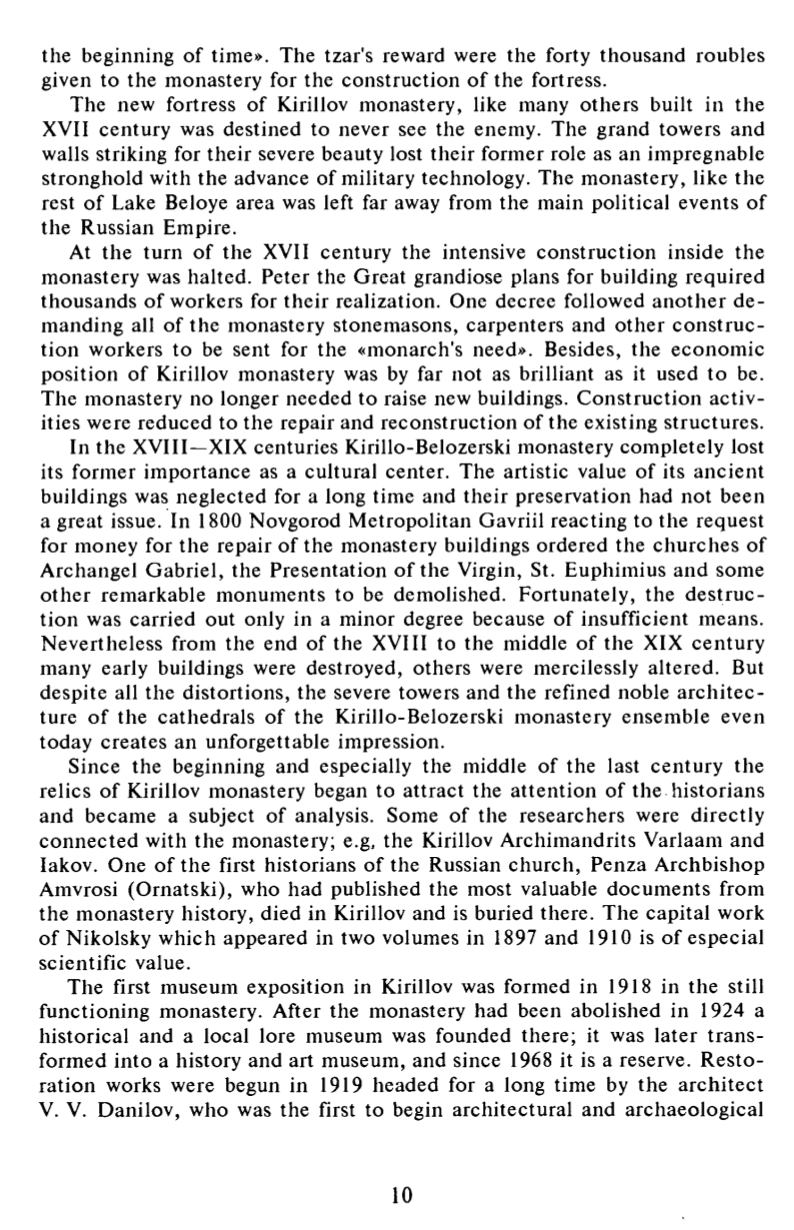

the beginning o f time». The tzar's reward were the forty thousand roubles
given to the monastery for the construction o f the fortress.
The new fortress o f Kirillov monastery, like many o thers built in the
XVII cen tury was destined to never see the enemy. The grand towers and
walls striking for their severe beauty lost their former role as an impregnable
strongho ld with the advance of m ilitary technology. The monastery , like the
rest o f Lake Beloye area was left far away from the main po litical events o f
the Russian Empire.
At the tu rn o f the XVII century the intensive construc tion inside the
monastery was halted. Peter the G reat grandiose plans for building requ ired
thousands o f workers for th e ir realization. One decree followed ano th e r d e
m anding all of the monastery stonemasons, carpen ters and o ther co n s tru c
tion workers to be sent for the «monarch's need». Besides, the econom ic
position o f Kirillov monastery was by far not as brillian t as it used to be.
The monastery no longer needed to raise new buildings. Con struc tion ac tiv
ities were reduced to the repair and reconstruction o f the existing structu res.
In the XV III—XIX centuries Kirillo-Belozerski monastery completely lost
its former importance as a cultural center. The artistic value o f its anc ien t
buildings was neglected for a long time and their preservation had no t been
a great issue. In 1800 Novgorod M etropolitan Gavriil reacting to the request
for money for the repair o f the monastery buildings ordered the chu rches o f
A rchangel Gab riel, the P resentation o f the Virgin, St. Euphim ius and some
o th e r remarkable monuments to be demolished. Fo rtunately , the d e s tru c
tion was carried out only in a minor degree because o f insufficien t means.
Nevertheless from the end o f the XVIII to the middle o f the XIX cen tu ry
many early buildings were destroyed, others were mercilessly altered . But
despite all the d isto rtions, the severe towers and the refined noble a rc h ite c
ture o f the cathed rals o f the Kirillo-Belozerski monastery ensemble even
today creates an unforgettable impression.
Since the beginning and especially the middle of the last cen tu ry the
relics o f Kirillov monastery began to a ttrac t the a tten tion o f the h istorians
and became a subject o f analysis. Some o f the researchers were d irectly
conn ec ted with the monastery; e.g, the Kirillov A rchimandrite Varlaam and
Iakov. One o f the first historians of the Russian chu rch , Penza A rchbishop
Amvrosi (O rnatsk i), who had published the most valuable docum en ts from
the monastery history , died in Kirillov and is buried there. The cap ital work
o f Nikolsky which appeared in two volumes in 1897 and 1910 is o f especial
scien tific value.
The first museum exposition in Kirillov was formed in 1918 in the still
function ing monastery. After the monastery had been abolished in 1924 a
h isto rical and a local lore museum was founded there; it was later tra n s
formed in to a history and art museum, and since 1968 it is a reserve. R e s to
ra tion works were begun in 1919 headed for a long time by the a rch itec t
V. V. Danilov, who was the first to begin arch itectu ral and archaeological
10















